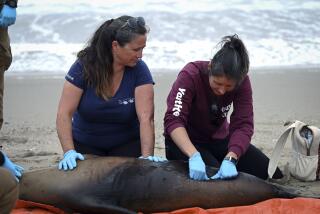Brown pelicans struggling to survive
- Share via
Reporting from Astoria, Ore. — All along the Oregon coast over the last month, hundreds of brown pelicans have turned up dead, starving or begging for food.
As many as 1,000 of the gangly seabirds failed to make their annual fall migration to California, many instead winding up at Oregon’s rehabilitation centers.
Those that did head south, leaving the Pacific Northwest winter behind, were battered by California’s recent storms. Shelters in San Pedro and the San Francisco Bay Area are also full of emaciated pelicans.
Researchers, at a loss to explain the casualties, are looking at unusual ocean currents and the depletion of fish stocks -- as well as warmer temperatures, toxic runoff and algae blooms -- as possible causes.
Meanwhile, pelicans are sitting listlessly on beaches and scavenging outside restaurants and canneries.
“In one parking lot, there were people in cars surrounded by pelicans asking for food. We have never seen that before,” said Roy Lowe, project leader for the Oregon Coast National Wildlife Refuge Complex. “These birds literally have lost all fear of humans.”
In San Pedro, the International Bird Rescue Research Center has taken in about 130 pelicans; a similar number are at the center’s Northern California facility.
“We’ve had unprecedented numbers coming in. Is it some kind of natural die-off? Is it related to some kind of changes in the fish supply? All we know is, we are reaching capacity,” said Paul Kelway of the San Pedro facility.
This is the second straight year that a large number of pelicans have remained in Oregon rather than trek to the warmer, quieter waters of California and Baja. From 1918 to 2002, the Audubon Society tallied fewer than 100 pelicans in Oregon every winter. Then the number shot up to 554 birds. In 2008, 3,647 stayed.
This year’s count isn’t in, but experts believe that about 3,100 birds remained along the Oregon coast.
“That’s pretty convincing to me that something unusual is going on,” said Deborah Jaques, a wildlife biologist in Astoria who specializes in seabirds.
Decades ago, the seabird population was devastated by DDT, which thinned pelicans’ eggshells. They were listed as endangered in 1970, but rebounded after the United States banned the pesticide in 1972.
Gradually, the pelicans’ summer range crept as far north as British Columbia. With their numbers reaching 650,000 throughout North and Central America, the birds were removed from the endangered species list in November.
At this point, few scientists are ready to attribute the recent die-off to global warming.
“This is the kind of thing you might expect to see with climate change, but we will need to do a better job of monitoring . . . to understand how they move in relation to their prey resources if we ever want to figure it out,” Jaques said.
Some researchers suggest that pelicans may have been taking advantage of an extended upwelling of deep, nutrient-rich waters to the surface -- normally limited to the spring and summer -- that provided a good winter food source along the Oregon coast. But the late stayers were hit in January by a sudden reversal in the upwelling, which sent food down toward the sea floor.
“And then we started getting windy days, and wind just grounds these birds,” said Dawn Grafe of the U.S. Fish and Wildlife Service. “They cannot get out and hunt for fish, and once they’re grounded for three or four days, they don’t have the strength to get out and do the fishing when the weather does improve.”
High, stormy surf sent a number of pelicans with broken wings into the Wildlife Center of the North Coast in Astoria, which has about 40 of the birds in rehabilitation.
“We probably had another 20 that died either before we could get them, or soon after they were captured,” said center director Sharnelle Fee. An examination of the birds revealed that nearly all had starved to death.
Wildlife officials have warned against feeding the birds, which could further injure them -- especially since, some researchers say, there may simply be too many pelicans.
“We have lots more birds. So . . . resources get kind of scarce,” said Julia Parrish, head of a regional seabird survey team. “If there’s a downturn in production in the system for whatever reason, we absolutely know that lots of organisms are going to starve. That’s how the ecosystem regulates itself. And it can be pretty ugly.”
More to Read
Sign up for Essential California
The most important California stories and recommendations in your inbox every morning.
You may occasionally receive promotional content from the Los Angeles Times.










